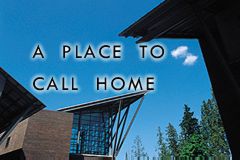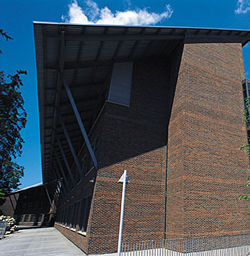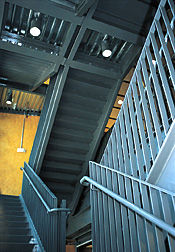
Sharing a Campus, Building Near the Wetlands
But while Rose and others were building the academic programs in the '90s, UWB still didn't have a place to call home. Originally the UW proposed building its own campus on the site of a golf course north of Woodinville. But Snohomish County officials wouldn't allow major development on the site, and in the meantime state planners decided a new community college was needed in the area.
Rather than build two separate campuses, the Legislature chose "co-location." UWB and a new community college would share one site and common facilities, such as student services, a library and parking. The state also decided to buy property at the intersection of I-405 and State Route 522, the Truly Farm, for the new campus, even though some of the property could never be developed due to wetlands.

A rich brown brick called "Forest Blend" covers all campus buildings, but each school has different banding patterns. Left is the south side of the UWB building.
Some UW administrators were not thrilled with the Truly Farm site. They knew that getting permits to develop the property would depend on wetlands approval from the U.S. Army Corps of Engineers. The property had long been on the market—there was even a proposal for a shopping mall, but the wetlands scared developers away. One regent complained that the site was "half swamp."
The UWB chancellor bristles at the description. "It is an asset as opposed to a liability," says Buck. "The irony—and this is as good as irony gets—is that the 'swamp' is going to be a marvelous, marvelous site for study," adds Rose. About half of the total campus, 58 acres, is set aside to become a restored wetland.
Someday giant trees will stand over a meandering stream—North Creek—in a setting reminiscent of the landscape prior to European settlement. Taking land that has been logged, drained, grazed and farmed and turning it back into a riverine setting will cost $7.2 million.
"It is impossible to recreate what was there 100 years ago," says Lyndon Lee, '83, a wetlands ecologist who oversees the restoration. The project will reconnect the creek to its original flood plain, establish a mosaic of native plant communities and become an attractive place for salmon, birds, beavers, raccoons and maybe even the occasional black bear.

Each school has its distinctive set of central stairways. At UWB, right, the stairs make an "X" pattern, while Cascadia Community College's stairs zigzag like a "Z."
"This is a big deal," says Lee. "It is a really unique site. We will have a fairly large patch of restored habitat in the midst of an urban setting." Technically, the state did not have to set aside this much space. By moving beyond what the law required, "the state not only did what they had to do, but it took the next step."
Buck and Rose say someday scientists from around the nation and the world will come to study the wetlands as they now travel to the UW's Friday Harbor Research Station in the San Juan Islands. "It is going to be a UW laboratory for the whole system," says Buck. Already the UW has awarded a $365,000 Tools for Transformation grant to faculty at all three UW campuses to study ecological restoration at the site and at wetlands close to the Seattle and Tacoma campuses.
Go To: Page 1 | Page 2 | Page 3 | Page 4
- Sidebar: Bothell Bits
- Sidebar: UW Bothell Opening Special Events
- See also Editor's Column on "Closed Doors, Open Possibilities"
- Return to September 2000 Table of Contents
Home / Current Issue / Archives / Talk Back / Advertising / Columns FAQ / Alumni Website / Search